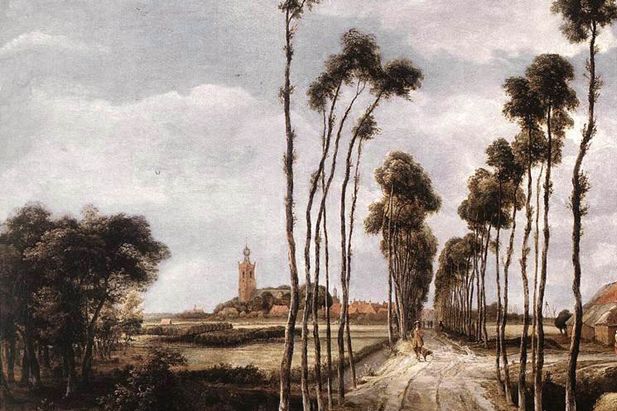



| |
Dutch Landscape Painter Hobbema   
No one knows much about the life of Dutch Master Painter Hobbema, but his master was doubtless his uncle, van Ruisdael. Hobbema was dead a hundred years before the world acknowledged his genius, thus he reaped no reward for hard work and ambition.
He, like Rembrandt, died in great poverty, and with nearly the same surroundings. Rembrandt died forsaken in Roosegraft Street, Amsterdam, and Hobbema died in the same locality. We must speak chiefly about his work, since we know little of his personality or affairs.
Hobbema's pictures seem to be composed of horizontal and vertical lines combined. We are not likely to find elevations or gentle, gradual depressions in his landscapes, but straight horizons, long trunked, straight limbed trees; and the landscape seems to be punctured here and there by an upright house or a spire. It is startlingly beautiful, and so characteristic that after seeing one or two of Hobbema's pictures we are likely to know his work again wherever we may find it.
Hobbema got at the soul of a landscape. It was as if one painted a face that was dear to one, and not only made it a good likeness but also painted the person as one felt him to be - all the tenderness, or maybe all the sternness.
It may be that Hobbema's failure to get money and honours, or at the very least, kind recognition as a great artist, while he lived, influenced his painting, and made him see mostly the sad side of beauty, nor it is certain that his landscapes give one a strange feeling of sadness and desolation, even when he paints a scene of plenty and fulness.
While this artist was not yet recognised, his uncle van Ruisdael was known as a great artist. The family must have been rich in spirit that gave so much genius to the world. Hobbema certainly loved his art above all things, for he had no return during his lifetime, save what was given by the joy of work. There are those who complain that Hobbema was a poor colourist. True, he used little besides grays and a peculiar green, which seemed especially to please him; but since that colouring belonged to the subjects he chose, one cannot complain on the ground that what he did was unsatisfying. For lack of knowledge
about him we can think of him as a man of moods, sad, desolate ones at that; because his work is too extreme and uniform in its character for us to believe his method was affected.
Perhaps is one of the most characteristic of Hobbema's pictures is the painting: "The Avenue of Middelharnis". Note a strange hopelessness in the scene, as well as beauty. The tall and solemn trees, the high light upon the road, suggesting to us all sorts of joys struggling through the cheerlessness of life. What other artist would have chosen such a corner of nature for a subject to paint? To quote a fine description:
"He loved the country-side, studied it as a lover, and has depicted it with such intimacy of truth that the road to Middelharnis seems as real today as it did over a hundred years ago to the artist. We see the poplars, with their lopped stems, lifting their bushy tops against that wide, high sky which floats over a flat country, full of billowy clouds as the sky near the North Sea is apt to be. Deep ditches skirt the road, which drain and collect the water for purposes of irrigation, and later on will join some deeper, wider canal, for purposes of navigation. We get a glimpse on the right, of patient perfection of gardening, where a man is pruning his grafted fruit trees; farther on a group of substantial farm buildings. On the opposite side of the road stretches a long, flat meadow, or "polder," up to the little village which nestles so snugly around its tall church tower; the latter fulfilling also the purpose of a beacon, lit by night, to guide the wayfarer on sea and land; scene of tireless industry, comfortable prosperity, and smiling peace. ... Pride and love of country breathe through the whole scene. To many of us the picture smiles less than it thrills with sadness. Perhaps it speaks thus only to those who find a kind of hurt in the revival of the spring, which promises so much and may fulfill so little."
Hobbema's "Watermill" is very well-known and so are his "Wooded Landscape," and "Haarlem's Little Forest." paintings.
 |
| The Avenue at Middelharnis, 1689 |
| Meindert Hobbema |
| 16x12 Giclee Print |
| Buy From Art.com |
 |
|
| |
|















